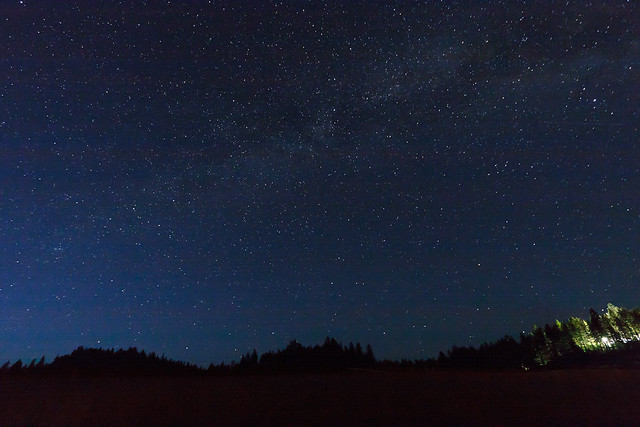
Last night, I had some folks over from the photo club for a little get together and fun. We grilled burgers, sat around the fire, and played with our cameras. We were mostly interested in shooting the night sky. I’ve shot the stars before, but last night might be my most successful attempt yet.
 Shooting the night sky is rather difficult, but it can be quite rewarding. One can end up with an image with more stars in it than the eye can see. The problem is that stars are not very bright, so to capture enough light, you have to use a long shutter speed. Therein lies another problem: stars move in the sky. One solution is to expose for a very long time and capture the star trails. With digital photography, this is a somewhat difficult approach. For one, the sensor is using battery power to capture the image. So the longer the exposure, the more battery gets used. An all-night exposure is nearly impossible. Using film, you can open the shutter forever and not draw any power.
Shooting the night sky is rather difficult, but it can be quite rewarding. One can end up with an image with more stars in it than the eye can see. The problem is that stars are not very bright, so to capture enough light, you have to use a long shutter speed. Therein lies another problem: stars move in the sky. One solution is to expose for a very long time and capture the star trails. With digital photography, this is a somewhat difficult approach. For one, the sensor is using battery power to capture the image. So the longer the exposure, the more battery gets used. An all-night exposure is nearly impossible. Using film, you can open the shutter forever and not draw any power.
The other option is the “short” exposure, and by short, I mean keeping it to 30 seconds or less. Even at 30 seconds, we begin to notice movement in the stars, but it may not be so much to detract from the image. The images on this post were taken at 30 seconds, but you only see star movement if we blow the image up pretty big. There one last trade-off to consider. Do you want a night sky with lots of stars and milky way detail, or do you want your image to be crisp and sharp all around? To get lots of light, you need a large aperture, f/2.8 or larger. But while large apertures let in lots of light, they’re also difficult to focus and lenses aren’t usually their sharpest at their widest aperture. Stopping down can get you a crisper image, but you’ll only pick up the brightest stars. But with practice and lots of patience, you can have your cake and eat it too.